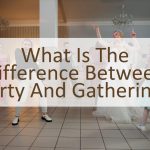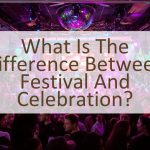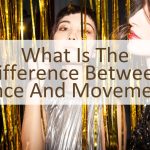Dance and movement are two terms that are often used interchangeably, but they have distinct differences. Dance involves the deliberate and intentional use of movements that are choreographed and performed to music or rhythm, while movement encompasses any type of physical action or motion.
In this blog post, we will explore the differences between dance and movement in more detail and why it’s important to distinguish between the two.
While dance involves a specific set of choreographed movements, movement is a more general term that encompasses any physical action or motion. Movement can refer to anything from walking to running to jumping to stretching, and it can be intentional or unintentional. Dance, on the other hand, is a type of movement that is intentional, deliberate, and often performed in a specific style or genre.
Dance is often associated with music or rhythm and is used to tell a story or express emotions. Dance movements are often choreographed and rehearsed, and the dancer’s movements are often synchronized with music or other dancers. In contrast, movement can be used for a variety of purposes, such as exercise, therapy, or everyday activities. While dance can be a form of exercise, not all movement is considered dance.
Another key difference between dance and movement is the level of skill and technique required. Dance is often associated with specific styles or genres, such as ballet, hip hop, or ballroom, and requires a high level of technical skill and training to perform. In contrast, movement does not necessarily require a specific level of skill or technique, and can be performed by anyone regardless of experience or training.
Overall, while dance and movement share some similarities, they have distinct differences that are important to understand. Distinguishing between the two can help individuals better appreciate and understand different types of physical expression and art forms.
What is Dance?
Dance is a type of performing art that involves the movement of the body, often accompanied by music. It is a form of expression and can convey emotions, stories, and cultural traditions. Dance can be performed by an individual or a group of people and can be classified into various styles, such as ballet, contemporary, hip hop, and jazz.
In ballet, dancers perform graceful and precise movements, often accompanied by classical music. The movements are structured and follow a specific technique. Ballet dancers typically wear pointe shoes, which allow them to dance on the tips of their toes.
Contemporary dance, on the other hand, is a more free-form style that incorporates elements of ballet, jazz, and modern dance. It often focuses on the emotions and experiences of the dancer, and the movements are more fluid and less structured than ballet.
Hip hop dance originated in African American and Latinx communities and is characterized by its energetic and rhythmic movements. It incorporates a wide range of styles, such as popping, locking, and breaking, and often includes improvisation and freestyling.
Jazz dance is a style that originated in the United States and combines elements of ballet, African American vernacular dance, and social dances. It is characterized by its syncopated rhythms and high-energy movements.
Despite the differences in style, all forms of dance involve the movement of the body in a rhythmic and expressive way. Dance can convey emotions, tell stories, and connect people across cultures and communities.
What is Movement?
Movement can be defined as any change in the position or posture of the body. It involves the use of various body parts to express emotions, ideas, or to communicate a message. Movement is not limited to the use of the feet or legs as seen in dance, but it can involve any part of the body. It can be used to tell a story or convey a message, but it does not necessarily have to follow a specific set of choreography or steps.
In everyday life, we use movement to perform our daily activities, such as walking, running, and even typing on a keyboard. Movement can also be used in art to express emotions or to convey a message. This is where the line between movement and dance can become blurred.
While dance is a form of movement, it is a more structured and deliberate use of movement to convey a specific message or emotion. Dance involves a set of choreographed steps that are often performed to music. The steps and movements are often designed to convey a particular message or to tell a story. The focus of dance is often on the technique and the execution of the steps.
Unlike movement, dance has a specific form and structure. There are various genres of dance, such as ballet, hip hop, and contemporary dance, and each has its own unique set of steps and movements. Dance also often requires a significant amount of training and practice to master.
In summary, while movement and dance share similarities in their use of the body to express emotions and ideas, the main difference lies in their structure and intention. Movement is any change in the position or posture of the body, while dance is a more structured and deliberate use of movement to convey a specific message or emotion.
What Are the Similarities Between Dance and Movement?
Dance and movement are both forms of expression that involve physical motion. They share a lot in common, as they both involve the body and require a level of coordination and skill to execute properly. One major thing they have in common is that they can both convey emotions and ideas without the need for words. They are also both used to tell stories and convey meaning.
Both dance and movement involve deliberate movements that are often choreographed, rehearsed, and performed. They both require discipline, practice, and focus to execute properly. In many cases, dance is considered a form of movement, as it is a more structured and stylized way of moving the body.
Another thing that dance and movement have in common is their ability to connect people. Whether it’s through group dances, partnering work, or individual performances, dance and movement can bring people together in a shared experience. They are also both used in therapeutic settings, as they can help individuals connect with their bodies and express themselves in a safe and supportive environment.
Overall, while dance and movement have some differences, they share a lot in common as well. They both involve intentional physical motion and can be used to convey emotions, tell stories, and bring people together. Whether you prefer to express yourself through dance or movement, both forms offer a powerful and creative way to connect with others and explore your own inner world.
What Are the Differences Between Dance and Movement?
Dance and movement are often used interchangeably, but they are not exactly the same thing. Dance is a specific form of movement that is often performed to music and follows a particular structure or choreography. Movement, on the other hand, is a broader term that encompasses any bodily action or gesture.
One significant difference between dance and movement is that dance is typically performed with an audience in mind. It is often choreographed and rehearsed, with the intention of telling a story or conveying a particular emotion to the viewer. In contrast, movement can be more improvisational and exploratory, with the focus on the individual’s experience of their own body.
Another difference between dance and movement is that dance often involves a certain level of technical skill and training. Dancers typically spend years honing their craft and perfecting their technique, whereas movement can be more intuitive and natural. That being said, there are certainly forms of movement that require a high level of skill and training, such as gymnastics or martial arts.
Finally, dance often has a cultural or historical context, with certain styles or forms of dance being associated with particular regions or time periods. Movement, on the other hand, can be more universal and timeless, transcending cultural or societal boundaries.
In conclusion, while dance and movement share some similarities, they are distinct forms of expression with their own unique qualities and characteristics. Understanding these differences can help us appreciate and enjoy both forms more fully.
Conclusion: Dance Vs. Movement
In conclusion, dance and movement are two related but distinct art forms that share some similarities but also have key differences. Dance involves a choreographed sequence of movements that are performed in a specific style or genre, often accompanied by music and with a performance aspect. Movement, on the other hand, encompasses a broader range of bodily actions that may or may not be choreographed or have a specific style or genre, and can be used for a variety of purposes beyond artistic expression.
Despite their differences, both dance and movement offer unique opportunities for creative expression, physical and emotional exploration, and cultural communication. By understanding the distinctions between these two art forms, we can better appreciate the diversity and richness of human movement and expression, and expand our appreciation for the vast array of ways in which we can communicate and connect through movement.







